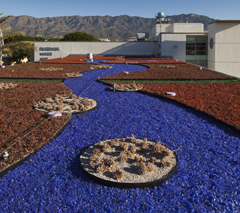Streetscaping reduces stormwater runoff, pollutants, at utility campus

The last time you passed an electric and water utility campus, you might have noticed an art deco facade, or maybe the building didn't particularly catch your eye. But no longer can public utility buildings be merely buildings. In an age of water scarcity, rising energy costs and increasing awareness of the role public utilities play in a metropolitan area's efforts to reduce consumption, public utilities need to reflect the efficiency and smart designs that their customers are seeking.
In California, Burbank Water and Power (BWP) has been making a number of upgrades to its facilities, including a new electric power plant in 2005. It recently unveiled a revamped campus that features five different stormwater management systems, all designed to capture and process stormwater run-off.
BWP worked with Los Angeles-based landscape architecture firm AHBE Landscape Architects to develop and manage the projects.

Along the sidewalk, planters containing drought- and storm-tolerant plants divert storm water, slowing it down and helping to filter out contaminants as the water percolates into groundwater aquifers. Permeable concrete pavers allow water to quickly pass over the sidewalk and into underground cells. These cells are designed to accomodate root growth from the adjacent street trees. Underground pods called biofilters are also used to process and clean stormwater.
Inside the campus, an old utility tunnel has been repurposed as a phytoextraction canal, filled with plants that can extract contaminants from the water before it passed into the soil. And the administrative building now has a green roof, which collects about 70 percent of the rainwater that falls on it, as well as reducing air pollutants and lowering ambient temperatures, which helps lower the building's energy needs.
The BWP campus has been entered as a pilot site into the Sustainable Sites Initiative (SITES), collaboration between the American Society of Landscape Architects, the Lady Bird Johnson Wildflower Center at The University of Texas at Austin and the United States Botanic Garden to create voluntary national guidelines and performance benchmarks for sustainable land design, construction and maintenance practices.
ABHE also provided water-saving landscaping for a water treatment plant in La Verne, Calif.
Images: Copyright Heliphoto
This post was originally published on Smartplanet.com
